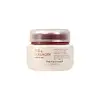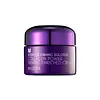What's inside
What's inside
 Key Ingredients
Key Ingredients

 Benefits
Benefits

 Concerns
Concerns

 Ingredients Side-by-side
Ingredients Side-by-side

Water
Skin ConditioningButyrospermum Parkii Butter
Skin ConditioningPropanediol
SolventPentaerythrityl Tetraethylhexanoate
EmollientGlycerin
HumectantDiisostearyl Malate
EmollientDimethicone
EmollientLimnanthes Alba Seed Oil
Skin Conditioning1,2-Hexanediol
Skin ConditioningPEG-100 Stearate
Glyceryl Stearate
EmollientStearyl Alcohol
EmollientPunica Granatum Fruit Extract
AntioxidantPanthenol
Skin ConditioningCaprylic/Capric Glycerides
EmollientPEG-240/Hdi Copolymer Bis-Decyltetradeceth-20 Ether
StabilisingSorbitan Sesquioleate
EmulsifyingHydroxyethyl Acrylate/Sodium Acryloyldimethyl Taurate Copolymer
Emulsion StabilisingSqualane
EmollientPolysorbate 60
EmulsifyingAdenosine
Skin ConditioningHydrolyzed Collagen
EmollientIllicium Verum Fruit Extract
PerfumingCaprylic/Capric Triglyceride
MaskingPotassium Hydroxide
BufferingAcrylates/C10-30 Alkyl Acrylate Crosspolymer
Emulsion StabilisingDisodium EDTA
Caprylyl Glycol
EmollientCI 77491
Cosmetic ColorantParfum
MaskingWater, Butyrospermum Parkii Butter, Propanediol, Pentaerythrityl Tetraethylhexanoate, Glycerin, Diisostearyl Malate, Dimethicone, Limnanthes Alba Seed Oil, 1,2-Hexanediol, PEG-100 Stearate, Glyceryl Stearate, Stearyl Alcohol, Punica Granatum Fruit Extract, Panthenol, Caprylic/Capric Glycerides, PEG-240/Hdi Copolymer Bis-Decyltetradeceth-20 Ether, Sorbitan Sesquioleate, Hydroxyethyl Acrylate/Sodium Acryloyldimethyl Taurate Copolymer, Squalane, Polysorbate 60, Adenosine, Hydrolyzed Collagen, Illicium Verum Fruit Extract, Caprylic/Capric Triglyceride, Potassium Hydroxide, Acrylates/C10-30 Alkyl Acrylate Crosspolymer, Disodium EDTA, Caprylyl Glycol, CI 77491, Parfum
Water
Skin ConditioningMethylpropanediol
SolventGlycerin
HumectantNeopentyl Glycol Diheptanoate
EmollientTriethylhexanoin
MaskingCyclopentasiloxane
EmollientCetearyl Olivate
Cetearyl Alcohol
Emollient1,2-Hexanediol
Skin ConditioningSorbitan Olivate
EmulsifyingCyclohexasiloxane
EmollientCaprylic/Capric Triglyceride
MaskingArgania Spinosa Kernel Oil
EmollientGlyceryl Stearate
EmollientPolyacrylate-13
Butylene Glycol
HumectantPolyisobutene
Limnanthes Alba Seed Oil
Skin ConditioningOenothera Biennis Oil
EmollientOlea Europaea Fruit Oil
MaskingCoptis Japonica Extract
AntimicrobialHydrolyzed Collagen
EmollientEthylhexylglycerin
Skin ConditioningCamellia Japonica Seed Oil
EmollientDextrin
AbsorbentTheobroma Cacao Extract
Skin ConditioningPolysorbate 20
EmulsifyingAdenosine
Skin ConditioningSorbitan Isostearate
EmulsifyingDisodium EDTA
Sodium Polyacrylate
AbsorbentSodium Hyaluronate
HumectantAllantoin
Skin ConditioningPanthenol
Skin ConditioningGlyceryl Linoleate
EmollientBeta-Glucan
Skin ConditioningPropylene Glycol
HumectantHydrolyzed Extensin
Skin ConditioningPrunus Amygdalus Dulcis Seed Extract
Skin ConditioningGlyceryl Linolenate
EmollientGlyceryl Arachidonate
EmollientIris Florentina Root Extract
MaskingPhenoxyethanol
PreservativeBiosaccharide Gum-1
HumectantPalmitoyl Tripeptide-5
Skin ConditioningSodium Benzoate
MaskingPotassium Sorbate
PreservativePhosphatidylcholine
EmulsifyingCopper Tripeptide-1
Skin ConditioningCeramide NP
Skin ConditioningGlycine
BufferingGlutamic Acid
HumectantSerine
MaskingLysine
Skin ConditioningAlanine
MaskingArginine
MaskingThreonine
Proline
Skin ConditioningWater, Methylpropanediol, Glycerin, Neopentyl Glycol Diheptanoate, Triethylhexanoin, Cyclopentasiloxane, Cetearyl Olivate, Cetearyl Alcohol, 1,2-Hexanediol, Sorbitan Olivate, Cyclohexasiloxane, Caprylic/Capric Triglyceride, Argania Spinosa Kernel Oil, Glyceryl Stearate, Polyacrylate-13, Butylene Glycol, Polyisobutene, Limnanthes Alba Seed Oil, Oenothera Biennis Oil, Olea Europaea Fruit Oil, Coptis Japonica Extract, Hydrolyzed Collagen, Ethylhexylglycerin, Camellia Japonica Seed Oil, Dextrin, Theobroma Cacao Extract, Polysorbate 20, Adenosine, Sorbitan Isostearate, Disodium EDTA, Sodium Polyacrylate, Sodium Hyaluronate, Allantoin, Panthenol, Glyceryl Linoleate, Beta-Glucan, Propylene Glycol, Hydrolyzed Extensin, Prunus Amygdalus Dulcis Seed Extract, Glyceryl Linolenate, Glyceryl Arachidonate, Iris Florentina Root Extract, Phenoxyethanol, Biosaccharide Gum-1, Palmitoyl Tripeptide-5, Sodium Benzoate, Potassium Sorbate, Phosphatidylcholine, Copper Tripeptide-1, Ceramide NP, Glycine, Glutamic Acid, Serine, Lysine, Alanine, Arginine, Threonine, Proline
Ingredients Explained
These ingredients are found in both products.
Ingredients higher up in an ingredient list are typically present in a larger amount.
1,2-Hexanediol is a synthetic liquid and another multi-functional powerhouse.
It is a:
- Humectant, drawing moisture into the skin
- Emollient, helping to soften skin
- Solvent, dispersing and stabilizing formulas
- Preservative booster, enhancing the antimicrobial activity of other preservatives
Adenosine is in every living organism. It is one of four components in nucleic acids that helps store our DNA.
Adenosine has many benefits when used. These benefits include hydrating the skin, smoothing skin, and reducing wrinkles. Once applied, adenosine increases collagen production. It also helps with improving firmness and tissue repair.
Studies have found adenosine may also help with wound healing.
In skincare products, Adenosine is usually derived from yeast.
Learn more about AdenosineThis ingredient is an emollient, solvent, and texture enhancer. It is considered a skin-softener by helping the skin prevent moisture loss.
It helps thicken a product's formula and makes it easier to spread by dissolving clumping compounds.
Caprylic Triglyceride is made by combining glycerin with coconut oil, forming a clear liquid.
While there is an assumption Caprylic Triglyceride can clog pores due to it being derived from coconut oil, there is no research supporting this.
Learn more about Caprylic/Capric TriglycerideDisodium EDTA plays a role in making products more stable by aiding other preservatives.
It is a chelating agent, meaning it neutralizes metal ions that may be found in a product.
Disodium EDTA is a salt of edetic acid and is found to be safe in cosmetic ingredients.
Learn more about Disodium EDTAGlycerin is already naturally found in your skin. It helps moisturize and protect your skin.
A study from 2016 found glycerin to be more effective as a humectant than AHAs and hyaluronic acid.
As a humectant, it helps the skin stay hydrated by pulling moisture to your skin. The low molecular weight of glycerin allows it to pull moisture into the deeper layers of your skin.
Hydrated skin improves your skin barrier; Your skin barrier helps protect against irritants and bacteria.
Glycerin has also been found to have antimicrobial and antiviral properties. Due to these properties, glycerin is often used in wound and burn treatments.
In cosmetics, glycerin is usually derived from plants such as soybean or palm. However, it can also be sourced from animals, such as tallow or animal fat.
This ingredient is organic, colorless, odorless, and non-toxic.
Glycerin is the name for this ingredient in American English. British English uses Glycerol/Glycerine.
Learn more about GlycerinGlyceryl Stearate is a mix of glycerin and stearic acid.
It is used to stabilize the mixing of water and oil ingredients. By preventing these ingredients from separating, it can help elongate shelf life. It can also help thicken the product's texture.
As an emollient, it helps soften skin and supports barrier-replenishing ingredients.
In cosmetics, Glyceryl Stearate is often made from vegetable oils or synthetically produced.
This ingredient may not be fungal-acne safe
Fun fact: The human body also creates Glyceryl Stearate naturally.
Learn more about Glyceryl StearateHydrolyzed collagen has a misleading name because it is actually a mixture of various proteins/peptides. This ingredient has skin hydrating properties.
Collagen is the most abundant type of structural protein found in your body. In your skin, it is responsible for keeping it firm and youthful.
Hydrolyzed Collagen is created by breaking up proteins into smaller peptide bonds. These peptides act as humectants and emollients.
Humectants are great at holding onto water, keeping skin hydrated. Emollients create a thin barrier on the skin to prevent moisture from escaping.
There is ongoing debate about whether hydrolyzed collagen works because it increases skin hydration. Skin hydration is also linked to elasticity and the appearance of wrinkles.
Collagen or peptide ingredients can be used in the morning or night. They will not increase sun sensitivity, but you should always wear sunscreen during the day.
According to a manufacturer, this ingredient is a great hair conditioner as well.
This ingredient can be extracted from different sources, including:
Vegan collagen is derived from yeast, bacteria, or plant sources. Vegan collagen would go by a different INCI name, such as hydrolyzed soy protein.
The results are varied.
A study from 2021 found hydrolyzed collagen increased elasticity and improved wrinkles in 1,125 participants between age 20 and 70. Another study found increased skin thickness in participants between the ages of 45 to 59.
However, It is difficult to prove that oral collagen will end up working on your skin. Many of the studies using hydrolyzed collagen also add several vitamins and nutrients into the test mixture as well.
Further studies are needed at this time.
Learn more about Hydrolyzed CollagenLimnanthes Alba Seed Oil is the oil extracted from the seeds of the meadowfoam plant. This oil is non-fragrant and is an emollient. As an emollient, meadowfoam seed oil helps soften and hydrate the skin.
Meadowfoam seed oil is stable and has a long shelf life due to its chemical structure. It has the highest concentration of stable fatty-acids among plant oils, preventing it from degrading once exposed to oxygen.
Due to the fatty acid content, this ingredient may not be fungal-acne safe.
Meadowfoam is native to California and Oregon.
Learn more about Limnanthes Alba Seed OilPanthenol is a common ingredient that helps hydrate and soothe the skin. It is found naturally in our skin and hair.
There are two forms of panthenol: D and L.
D-panthenol is also known as dexpanthenol. Most cosmetics use dexpanthenol or a mixture of D and L-panthenol.
Panthenol is famous due to its ability to go deeper into the skin's layers. Using this ingredient has numerous pros (and no cons):
Like hyaluronic acid, panthenol is a humectant. Humectants are able to bind and hold large amounts of water to keep skin hydrated.
This ingredient works well for wound healing. It works by increasing tissue in the wound and helps close open wounds.
Once oxidized, panthenol converts to pantothenic acid. Panthothenic acid is found in all living cells.
This ingredient is also referred to as pro-vitamin B5.
Learn more about PanthenolWater. It's the most common cosmetic ingredient of all. You'll usually see it at the top of ingredient lists, meaning that it makes up the largest part of the product.
So why is it so popular? Water most often acts as a solvent - this means that it helps dissolve other ingredients into the formulation.
You'll also recognize water as that liquid we all need to stay alive. If you see this, drink a glass of water. Stay hydrated!
Learn more about Water